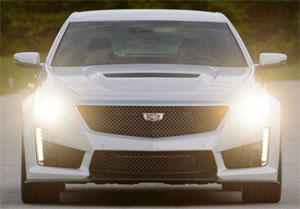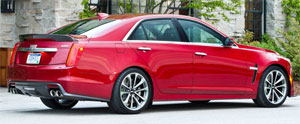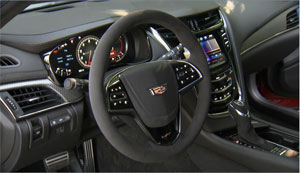2016 Cadillac CTS-V
No matter where your car company hails from, if you build a sport sedan, you’ll ultimately get compared to the companies that have done it the best, for the longest time: The Germans! BMW, Mercedes, and VW/Audi. Whether that’s fair or not, is a topic for another day. Because right now, we’ve got a home grown contender to put through its paces, the Cadillac CTS-V!
American carmakers have been trying to catch up, and one-up the German sport sedan concept for over half a century. Numerous times critics, including us, thought they got close. But, it took the 21st century Cadillac brand to really close the gap, with the 2016 CTS-V aiming to fill it for good.
The CTS-V is the original V “for Velocity” of course, but just about everything that makes it go fast now, comes from the Chevrolet Corvette; making this essentially a four-door Corvette with a nicer interior.
That kinship start naturally enough under the hood with the Z06’s glorious 6.2-liter chunk of supercharged aluminum with pushrods, producing 640-horsepower and 630 lb-ft. of torque. The M5 and E63 AMG don’t even come close.
This thing is clearly not some mild-mannered pretender. Just hearing it rumble at startup will put fear into you; floor it and its “oh my gosh” awesome power!
 It is still built on the ATS platform, but significant structural bracing had to take place; and like some of us around here, has stiffer joints all around. Oh yeah, it’s race car rigid.
It is still built on the ATS platform, but significant structural bracing had to take place; and like some of us around here, has stiffer joints all around. Oh yeah, it’s race car rigid.
Just as in some front-wheel-drive transaxles that feature unequal half-shafts to prevent torque steer; a similar arrangement in the CTS-V’s rear, works to quell axle hopping on hard acceleration. The results are, according to the factory, a blistering 3.7-seconds to 60.
There are Brembo brakes obviously; and topping it off, GM stuffed as much rubber into the wheel wells as possible; 265/35/19 Michelin Pilot Super Sports in front, 295/30/19s in back.
We’ve said it many times before about V-Series cars; you really need to get them on a race track for full affect. Tooling to the winery on the weekend or even slicing up your local back roads in this CTS-V does not reveal the true story of how competent it is.
So we jumped at the change to try it out a Road America! Yep, this Caddy is one awesome track machine. Between Performance Traction Management and the power distributing electronic limited-slip differential, you have no trouble getting all 640 horses to the pavement with little concern about being out of control.
 More power than the Germans, and better use of it than hotrods like Hellcats and Shelby’s. And that very linear power delivery also works well with the 8-speed automatic transmission that comes with all CTS-Vs.
More power than the Germans, and better use of it than hotrods like Hellcats and Shelby’s. And that very linear power delivery also works well with the 8-speed automatic transmission that comes with all CTS-Vs.
There’s plenty of mid-range muscle coming out of turns; with minimal weight transfer thanks to Magnetic Ride Control, even with a hefty 4,145-lbs. to manage. Brakes are all day long durable.
Driven hard it seems to move around on you a little, but it seems to catch itself and never get out of shape. You know there’s electronic intervention happening, but you still feel in total control.
There’s a more aggressive look to go along with all of that performance. Virtually every body panel is unique and purposefully designed to maximize downforce, minimize lift, or enhance cooling.
The air-extracting hood is made of carbon fiber as are the front splitter, rear diffuser, and spoiler if you opt for the carbon fiber package.
 As for the interior, thankfully it does not appear like it was done on a shoestring budget; just an enhanced performance feel thanks to sueded materials, performance seats, Head Up display, and of course the Corvettes’ Performance Data Recorder.
As for the interior, thankfully it does not appear like it was done on a shoestring budget; just an enhanced performance feel thanks to sueded materials, performance seats, Head Up display, and of course the Corvettes’ Performance Data Recorder.
And perhaps most important of all, it doesn’t feel any less Cadillac when you’re driving sanely.
Government Fuel Economy Ratings are 14-City, 21-Highway, and 17-Combined. So there is a gas guzzler tax.
Base price is $85,990. And if that’s too much, don’t forget that this big V has a little brother ATS-V which packs almost as much performance for $61,460.
Now, we know that many sport sedan aficionados will never be convinced that a four-door designed anywhere but Germany is worth a second look. But, if you have an open mind, then you’ll see where we’re coming from when we say that hands down, the 2016 Cadillac CTS-V beats all comers in the traditional European sport sedan category in every way! And we’re just ecstatic to be along for the ride.
Specifications
- Engine: 6.2 liter
- Horsepower: 640
- Torque: 630 lb-ft.
- 0-60 mph: 3.7 seconds
- EPA: 14 mpg city / 21 mpg highway
2025 Volkswagen ID. Buzz
Volkswagen Brings Beetlemania Level Of Excitement To Minivan Segment
The duty of upholding Volkswagen’s heritage has most recently been delegated to small legacy car names like Golf and Jetta. But hold on! A much larger, totally modern take on VW’s classic microbus has just buzzed over the horizon— the all-electric ID. Buzz. It’s been at the top of our minds since we first saw the concept back in 2017. Well, it’s finally here, so let’s get our groove into drive!
This 2025 Volkswagen ID. Buzz has indeed created the most buzz around Volkswagen since the Beetle’s return to the U.S. in the late 1990s. We couldn’t drive it anywhere without drawing a crowd. No wonder, just about everyone has a VW Microbus story to tell, and seeing this reimagined version rolling down the street brings back all those memories.
VW really pulled it off as far as we’re concerned, as it looks great without appearing over the top. All the cues are here: Big VW logo front and center, lots of greenhouse including A-pillar windows and mini sliders for the second-row passengers, D-pillar air vents, and two-tone wheels. And while its appearance may be pure retro, its drivetrain is far from it, as the ID. Buzz is all-electric, and unlike the new Beetle, the Buzz does retain the original Microbus’ rear-drive architecture.
Powering those rear wheels is a 210-kW motor drawing juice from a 91-kWh battery for a range of 234 miles; 200-kW max charging will get you to 80% in about 26 minutes. Buyers can add another small 80-kW motor up front for 4motion all-wheel-drive and an increase of total output from 282 to 335 horsepower with a combined 512 lb-ft of torque. It uses the same battery, but range estimates drop just slightly to 231 miles. But while those numbers are modest, we also found them to be quite conservative, as we observed as many as 287 miles available in our all-wheel-drive tester’s gauge display and were on pace for 273 miles in our driving loop.
One throwback theme that may be a turnoff to some is that it’s quite a step up into the Buzz’s front seats, but there’s certainly a commanding view of the road once you climb in. Second row seating can be either a three-place bench or a pair of captain’s chairs, so there’s generous room for seven or six passengers. The captain’s chairs in our Pro S Plus offer good support and very easy access to the third row.
Lots of flexibility too with the option to simply fold the seats or remove them altogether.
With the sliding side doors and a wide opening rear hatch, there’s plenty of access for loading big sport utility amounts of cargo. Lots of flexibility too with the option to simply fold the seats or remove them altogether, and the ability to create a full-length flat floor with a rear cargo shelf that covers some handy removable storage bins. There’s 18.6 cubic-feet of space behind the third row, 75.5 behind the second, and a max of 145.5. That’s more than a Chevrolet Tahoe. For smaller items, there are lots of cubbies throughout the cabin, along with a standard Buzz Box that can be moved to multiple locations.
With a design that prioritizes retro form and modern function over aero efficiency, the 4motion equipped ID. Buzz earns a Fair efficiency rating, using 42-kWh of electricity per 100 miles, and we weren’t sure what to expect at our Mason Dixon test track.
What we found was great torque off the line and drama free launches to 60 in just 5.3 seconds. It was very stable at speed and power delivery stayed steady most of the way down the track until we reached about 90 mph, when it began to taper off just before we finished the quarter-mile in 14.0 seconds flat at 97 mph.
With 1,200-lbs. of battery weight nestled in its 127.5-inch wheelbase, the Buzz felt planted to the pavement through our handling course. There was quite a bit of body roll to deal with, but surprisingly little understeer. In panic braking runs, pedal response was inconsistent, feeling soft at times, pushing back hard at others; but through it all, results were quite good, stopping from 60 in an average of just 108 feet.
Three interior themes are available, this Dune is the brightest, featuring coastal inspired wood optic dash décor, “gray and clay” leatherette surfaces, and a high-mounted central 12.9-inch touchscreen. Pricing starts with a rear-wheel-drive Pro S at $61,545; this Pro S Plus begins at $65,045, add another $4,500 for 4motion, which brings a few extra features along with all-wheel drive.
Retro design with old-school VW charm, modern EV drivetrain, big SUV capacity merged with minivan flexibility; it all comes together in this 2025 Volkswagen ID. Buzz. It’s easily one of the coolest rides of the year and one that will likely keep Volkswagen dealers buzzing for years to come, and that’s something no other people and things mover can say.
Specifications
As Tested
- Motor Setup: Dual-Motor AWD
- Battery Size: 91-kWh
- Horsepower: 335
- Torque: 512 lb-ft
- EPA Range: 231 miles
- 0-60 mph: 5.3 seconds
- 1/4 Mile: 14.0 seconds at 97 mph
- Braking, 60-0: 108 feet
- MW Test Loop: ~ 273 miles













































